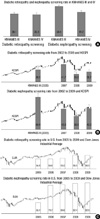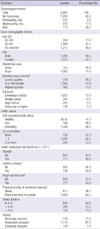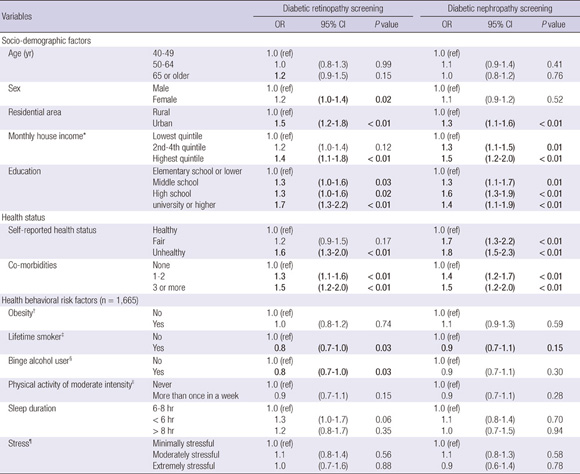Abstract
Figures and Tables
 | Fig. 2Screening rates of diabetic retinopathy and nephropathy. (A) Diabetic retinopathy screening rates are 38.1% (SE 5.5) in Korea National Health and Nutrition Examination Survey 2005 (KNHANES III) and 36.9% (SE 5.8) in KNHANES IV. Diabetic nephropathy screening rates are 50.4% (SE 5.3) in KNHANES III and 41.2% (SE 5.8) in KNHANES IV. (B) The averages of diabetic retinopathy screening rates were 38.1% (SE 5.5) in 2005, 41.7% (SE 14.2) in 2007, 35.2% (SE 9.4) in 2008, and 36.7% (SE 8.8) in 2009. In terms of diabetic nephropathy screening, the rates were 42.9% (SE 14.4) in 2007, 38.3% (SE 9.3), and 43.2% (SE 8.6) in 2009. The Korea Composite Stock Price Index (KOSPI) goes parallel with the diabetic retinopathy and nephropathy screening rates. (C) The averages of diabetic retinopathy screening rates in the United States were 54.8 in 2005, 54.6 in 2006, 55.0 in 2007, 56.5 in 2008, and 56.5 in 2009. The averages of diabetic nephropathy screening rates were 55.1 in 2005, 79.7 in 2006, 80.6 in 2007, 82.4 in 2008, and 82.9 in 2009. The Dow Jones Industrial Average (DJIA) decreased after 2007, but both diabetic retinopathy and nephropathy screening rates gradually increased. |
Table 1

*To derive income per adult, we used the following formula: income/square root of the number of persons in the household; †We used the World Health Organization's BMI-defined obesity standard (≥ 25 kg/m2) for adults; ‡Lifetime smokers included subjects who reported that they have smoked at least 100 cigarettes in their lifetime and now smoke; §Binge alcohol users were defined as those who consume more than 7 drinks on a single occasion for men, and 5 drinks on a single occasion for women, on one or more occasions in a month; ∥Moderate-intensity activities were defined as lasting at least 30 min and increasing the heart rate slightly, as compared with sedentary activities; ¶Stress was assessed with the question: "How much stress do you feel on a daily basis?"
Table 2

*To derive income per adult, we used the following formula: income/square root of the number of persons in the household; †Lifetime smokers included subjects who reported that they have smoked at least 100 cigarettes in their lifetime and now smoke; ‡Binge alcohol users were defined as those who consume more than 7 drinks on a single occasion for men, and 5 drinks on a single occasion for women, on one or more occasions in a month; Bold facerepresent P-values that are statistically significant.
Appendix
Appendix 1
The factors associated with screening for diabetes complications-univariate analysis (n = 2,660)





 PDF
PDF ePub
ePub Citation
Citation Print
Print



 XML Download
XML Download